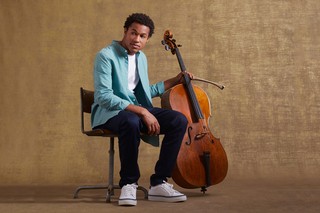|
Back
Debussy in the Key of Sea New York
Isaac Stern Auditorium, Carnegie Hall
10/22/2022 - & October 21, 2022 (Bethesda)
Sir Edward Elgar: Cello Concerto in E minor, Opus 85
Thomas Adès: The Exterminating Angel Symphony (NY premiere)
Claude Debussy: La Mer
Sheku Kanneh‑Mason (Cellist)
City of Birmingham Symphony Orchestra, Mirga Grazinytė‑Tyla (Conductor/Principal Guest Conductor)

M. Grazinytė‑Tyla (© CBSO)
“Eastbourne is a charming peaceful spot: the sea unfurls itself with an utterly British correctness.”
Claude Debussy, finalizing La Mer at Eastbourne’s Grand Hotel
The Grand Hotel still commands the beach over English Channel, Debussy is still revered as one of its celebrities, dating back to his short residence in 1905. But the composer himself rarely went down to the sea. La Mer was a mer of the mind. Debussy’s sea was not liquid: it was the Hokusai eternal wave which adorned the original score.
But as the grand finale to the grand conducting of Mirga Grazinytė‑Tyla and the City of Birmingham Symphony Orchestra, Debussy’s inner sea was a series of glorious pictures.
The diminutive Ms. Grazinytė‑Tyla stretched over her orchestra like Poseidon over the Aegean. Hers, in fact was a personal command. (Ms. Grazinytė‑Tyla had been offered the post of Musical Director. But the peripatetic Lithuania‑born conductor preferred being Principal Guest Conductor of the Birmingham group.) Her Mer was not tranquil. Wind and waves–and the mighty brass–of the orchestra made their stunning mark.
Working with the Birmingham Orchestra is not working with a provincial ensemble. And is certainly not for the timid. Its very first concert, 102 years ago, was led by Sir Edward Elgar himself. Six decades later, like James Levine lifting the pedestrian Met Orchestra into a world-class ensemble, Sir Simon Rattle went to this industrial town and made his City of Birmingham Orchestra into an ever-youthful aggregate.

S. Kanneh‑Mason
One could hear it in Sir Edward’s Cello Concerto where they played all too well accompanying British cellist Sheku Kanneh‑Mason.
One must resist comparing any cellist with Jacqueline du Pré. Not that she was anything but wonderful, but that her life is depicted more as hagiography than artist. Mr. Kanneh‑Mason eschewed her great swells and swirls of the Elgar. In fact, so subtle was he that the playing was sometimes overcome by the orchestra. He gave a studied first movement, but his elegance as a cellist eliminated some of the great Elgarian climaxes. The second movement again showed his virtuosity, but also showed a perhaps cerebral avoidance of the great measures.
No accomplished cellist can destroy the final movement, and Mr. Kanneh‑Mason is obviously the consummate artist. His subtlety, though, was more fitting for his encore, a Bach arrangement for his solo and four Birmingham cellists.
These works are (rightly) part of the repertory. The Exterminating Angel Symphony (co‑commissioned by Carnegie Hall) comes from the pen of the most creative, amazing, masterful composer living in England. I have never seen Thomas Adès’ opera The Exterminating Angel, possibly because I short‑sightedly felt that no singing, no stage work could outdo Luis Bunuel’s original film (which I have seen three times!).
Making a “symphony” rather than a suite, would be, I felt, for those who didn’t go to the Met for the opera. The only other “symphony” which actually is more popular than the opera is Hindemith’s Mathis der Maler. Mr. Adès’ work was more similar to Alban Berg’s Lulu Suite, even the orchestration.
Mr. Adès does not stint on his orchestra. Brass, timpani, huge string sections in three of the four movements. In fact, this work is a bombardment of the ears. Does one have to know the opera to understand what’s going? Not necessarily. But it absolutely does help.
We could sit back and enjoy the dazzling orchestration, the bombardment of trumpets and timpani, the march, and opening fanfares. Still, if we knew the film (or the opera), it would help to know that these were the processions of the characters coming into a post‑opera cocktail party. (Spoiler alert: They are trapped: they will never come out.) If we could picture the cast coming in, then each change of color or reveille might make for sense.
The third-movement “Berceuse” seemed a bit pokey But the finale waltz is an Adès masterpiece. Does it sound like a perverted Johann Strauss, do those pile atop pile atop pile sound like the climax of La Valse? Well then, so be it.
The Symphony is a jewel of orchestration and breathless inspiration. Ms. Grazinytė‑Tyla had the Birmingham orchestra under her command, and the results of this piece were often breathtaking.
Harry Rolnick
|